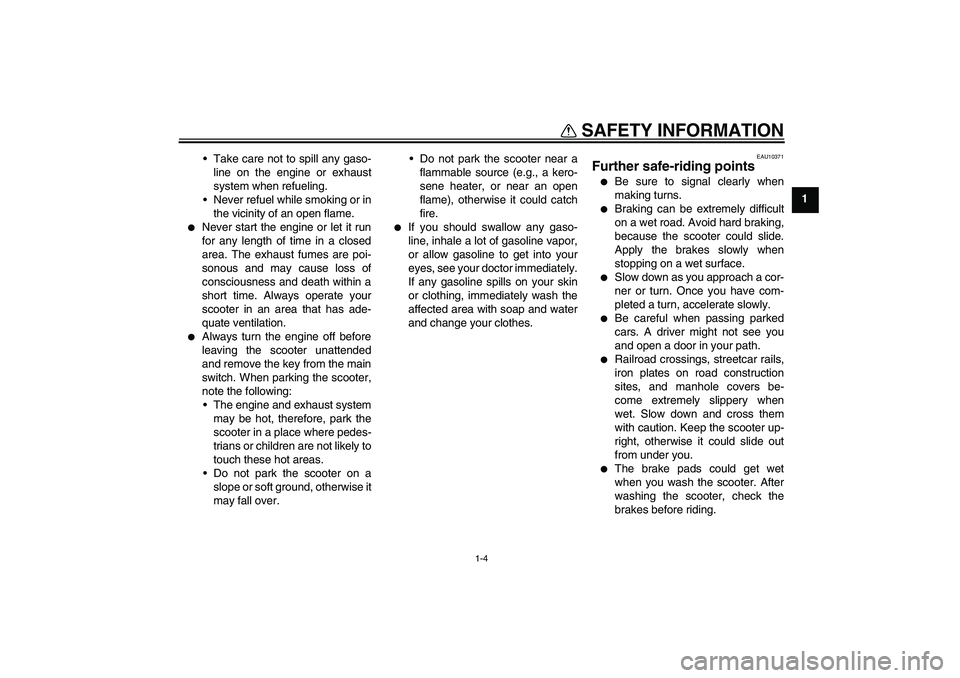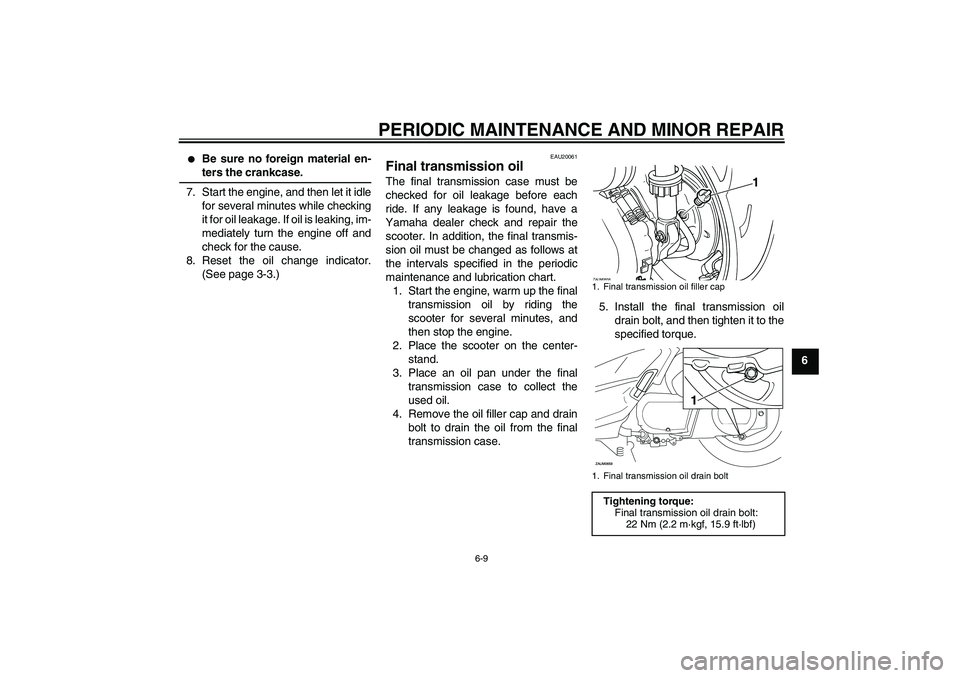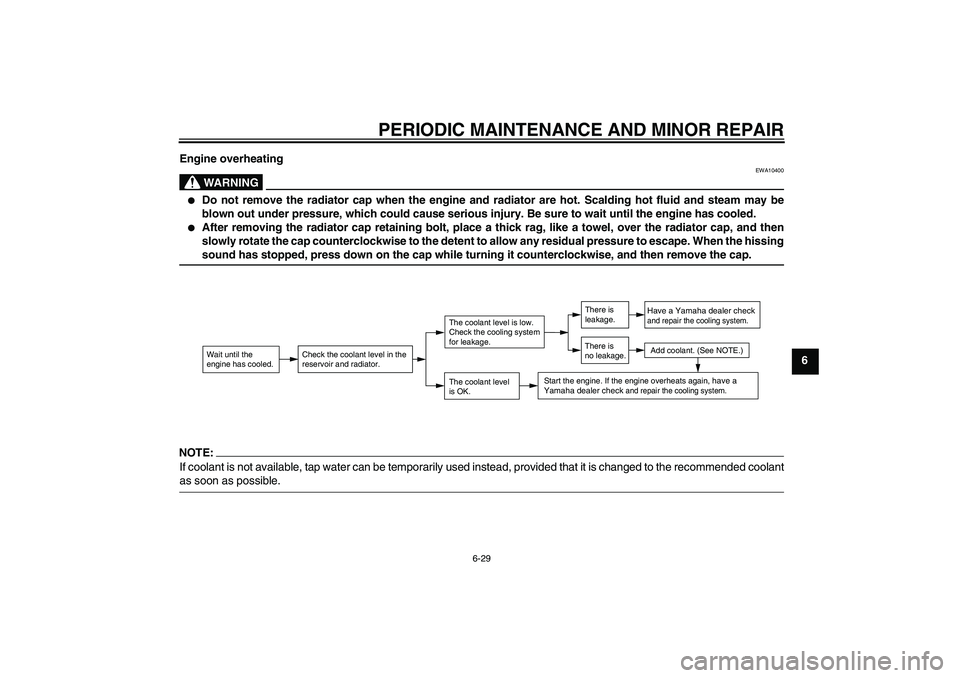Page 11 of 78

SAFETY INFORMATION
1-4
1 Take care not to spill any gaso-
line on the engine or exhaust
system when refueling.
Never refuel while smoking or in
the vicinity of an open flame.
�
Never start the engine or let it run
for any length of time in a closed
area. The exhaust fumes are poi-
sonous and may cause loss of
consciousness and death within a
short time. Always operate your
scooter in an area that has ade-
quate ventilation.
�
Always turn the engine off before
leaving the scooter unattended
and remove the key from the main
switch. When parking the scooter,
note the following:
The engine and exhaust system
may be hot, therefore, park the
scooter in a place where pedes-
trians or children are not likely to
touch these hot areas.
Do not park the scooter on a
slope or soft ground, otherwise it
may fall over.Do not park the scooter near a
flammable source (e.g., a kero-
sene heater, or near an open
flame), otherwise it could catch
fire.
�
If you should swallow any gaso-
line, inhale a lot of gasoline vapor,
or allow gasoline to get into your
eyes, see your doctor immediately.
If any gasoline spills on your skin
or clothing, immediately wash the
affected area with soap and water
and change your clothes.
EAU10371
Further safe-riding points �
Be sure to signal clearly when
making turns.
�
Braking can be extremely difficult
on a wet road. Avoid hard braking,
because the scooter could slide.
Apply the brakes slowly when
stopping on a wet surface.
�
Slow down as you approach a cor-
ner or turn. Once you have com-
pleted a turn, accelerate slowly.
�
Be careful when passing parked
cars. A driver might not see you
and open a door in your path.
�
Railroad crossings, streetcar rails,
iron plates on road construction
sites, and manhole covers be-
come extremely slippery when
wet. Slow down and cross them
with caution. Keep the scooter up-
right, otherwise it could slide out
from under you.
�
The brake pads could get wet
when you wash the scooter. After
washing the scooter, check the
brakes before riding.
Page 16 of 78

INSTRUMENT AND CONTROL FUNCTIONS
3-1
3
EAU10460
Main switch/steering lock The main switch/steering lock controls
the ignition and lighting systems, and is
used to lock the steering. The various
positions are described below.
EAU34121
ON “”
All electrical circuits are supplied with
power; the meter lighting, taillight, li-
cense plate light and auxiliary lights
come on, and the engine can be start-
ed. The key cannot be removed.NOTE:The headlights come on automatically
when the engine is started and stay on
until the key is turned to “” or the sid-estand is moved down.
EAU10660
OFF “”
All electrical systems are off. The key
can be removed.
EAU10680
LOCK “”
The steering is locked, and all electrical
systems are off. The key can be re-
moved.
To lock the steering1. Turn the handlebars all the way to
the left.
2. Push the key in from the “” posi-
tion, and then turn it to “” while
still pushing it.
3. Remove the key.
To unlock the steeringPush the key in, and then turn it to “”
while still pushing it.
WARNING
EWA10060
Never turn the key to “” or “”
while the vehicle is moving, other-
wise the electrical systems will be
switched off, which may result inloss of control or an accident. Make
sure that the vehicle is stopped be-
fore turning the key to “” or “”.
PUSHOPEN
ZAUM0253
Page 29 of 78
INSTRUMENT AND CONTROL FUNCTIONS
3-14
3
With the engine turned off:
1. Move the sidestand down.
2. Make sure that the engine stop switch is turned on.
3. Turn the key on.
4. Keep the front or rear brake applied.
5. Push the start switch.
Does the engine start?
With the engine still off:
6. Move the sidestand up.
7. Keep the front or rear brake applied.
8. Push the start switch.
Does the engine start?
With the engine still running:
9. Move the sidestand down.
Does the engine stall?
The system is OK. The scooter can be ridden.
This check is most reliable if performed with
a warmed-up engine.The sidestand switch may be defective.
The scooter should not be ridden until
checked by a Yamaha dealer.
The brake switch may be defective.
The scooter should not be ridden until
checked by a Yamaha dealer.
The sidestand switch may be defective.
The scooter should not be ridden until
checked by a Yamaha dealer.
YES NO YES NO NO YESNOTE:
Page 45 of 78

PERIODIC MAINTENANCE AND MINOR REPAIR
6-9
6
�
Be sure no foreign material en-ters the crankcase.
7. Start the engine, and then let it idle
for several minutes while checking
it for oil leakage. If oil is leaking, im-
mediately turn the engine off and
check for the cause.
8. Reset the oil change indicator.
(See page 3-3.)
EAU20061
Final transmission oil The final transmission case must be
checked for oil leakage before each
ride. If any leakage is found, have a
Yamaha dealer check and repair the
scooter. In addition, the final transmis-
sion oil must be changed as follows at
the intervals specified in the periodic
maintenance and lubrication chart.
1. Start the engine, warm up the final
transmission oil by riding the
scooter for several minutes, and
then stop the engine.
2. Place the scooter on the center-
stand.
3. Place an oil pan under the final
transmission case to collect the
used oil.
4. Remove the oil filler cap and drain
bolt to drain the oil from the final
transmission case.5. Install the final transmission oil
drain bolt, and then tighten it to the
specified torque.
1. Final transmission oil filler cap
1. Final transmission oil drain bolt
Tightening torque:
Final transmission oil drain bolt:
22 Nm (2.2 m·kgf, 15.9 ft·lbf)
1
ZAUM0658
Page 65 of 78

PERIODIC MAINTENANCE AND MINOR REPAIR
6-29
6 Engine overheating
WARNING
EWA10400
�
Do not remove the radiator cap when the engine and radiator are hot. Scalding hot fluid and steam may be
blown out under pressure, which could cause serious injury. Be sure to wait until the engine has cooled.
�
After removing the radiator cap retaining bolt, place a thick rag, like a towel, over the radiator cap, and then
slowly rotate the cap counterclockwise to the detent to allow any residual pressure to escape. When the hissingsound has stopped, press down on the cap while turning it counterclockwise, and then remove the cap.
NOTE:If coolant is not available, tap water can be temporarily used instead, provided that it is changed to the recommended coolantas soon as possible.
Wait until the
engine has cooled.
Check the coolant level in the
reservoir and radiator.
The coolant level
is OK.The coolant level is low.
Check the cooling system
for leakage.
Have a Yamaha dealer checkand repair the cooling system.Add coolant. (See NOTE.)
Start the engine. If the engine overheats again,
have a
Yamaha dealer check
and repair the cooling system.
There is
leakage.
There is
no leakage.